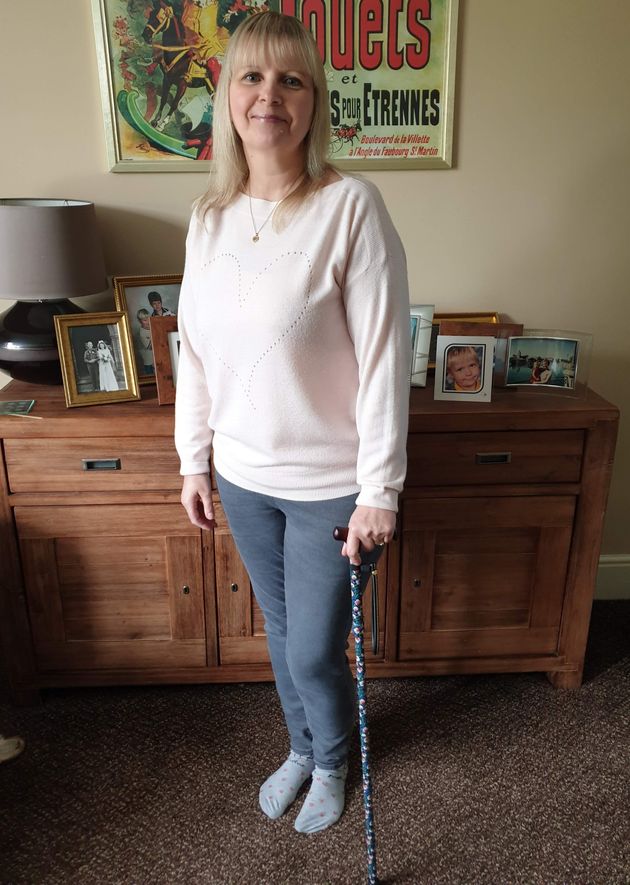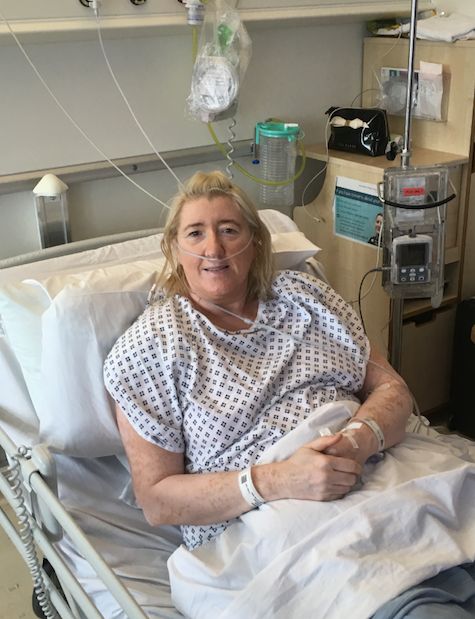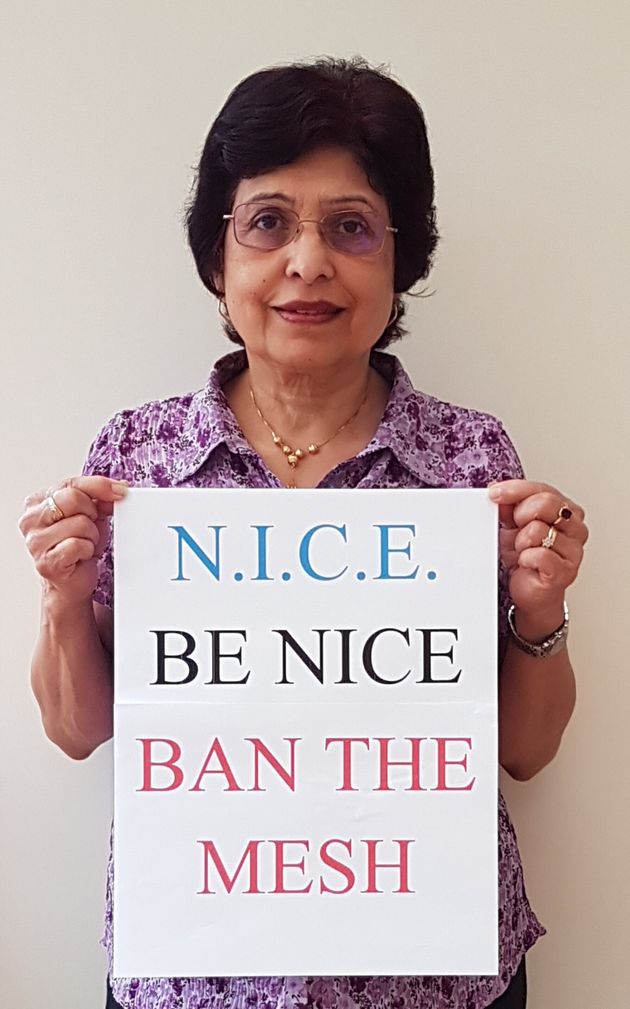At the age of 38, Joanne Lloyd had vaginal mesh surgery designed to treat the stress urinary incontinence she experienced after the birth of her three children.
What followed that 2004 operation was more than a decade of pain so intense that Lloyd was forced to leave her job of 16 years as an NHS receptionist.
“It felt like glass or razor blades inside me. It was just horrendous,” Lloyd, now 53, tells HuffPost UK. “My whole life changed. We were keen mountain walkers. We went to Glastonbury… I went from being a very sociable person who was always out to being a recluse.”
On Thursday morning, Lloyd will join other vaginal mesh patients as they protest outside the National Institute for Health and Care Excellence (NICE) annual conference in Manchester. The women, some of whom have been confined to wheelchairs after mesh surgery, say the NICE guidelines ignore patients’ stories and are “not fit for purpose”.
Later in the day, protestors will gather in London outside UCLH (University College London Hospitals), calling for better access to mesh removal treatment.

A vaginal mesh implant is a synthetic net material, used to strengthen weak connective tissue or ligaments (often the result of childbirth). The mesh is designed to hold the pelvic organs – the uterus, vagina, bowel and bladder –in place, helping treat incontinence and pelvic organ prolapse – the bulging of pelvic organs into the vagina.
The use of vaginal mesh was paused last year amid safety concerns. But the latest NICE guidelines, released in April, effectively reinstated the treatment, saying it could be used if non-surgical options hadn’t been effective in treatment. NICE added: “There is limited evidence on possible long-term harms of all surgical options.”
This is despite thousands of women worldwide reporting complications, which can occur when the synthetic mesh moves out of place or erodes, breaking down into smaller pieces. Patients’ anecdotes have been echoed in some scientific studies.
After hearing about the Sling the Mesh campaign on TV in 2017, Lloyd went straight to the doctor with her list of symptoms. On previous visits, she says, doctors did not link the problems she was experiencing to the mesh.
She was referred for specialist treatment and underwent two operations – to remove the mesh and to treat her incontinence with an alternative mesh-free operation. Despite the surgeries, Lloyd still experiences nerve pain every day due to the internal damage.
Revealing why she’s joining today’s protest, she said: “I feel like they [NICE] haven’t taken us into consideration at all and our lives and how they’ve been ruined by mesh.
“I don’t want anyone else – my daughters, nieces, family and friends – to go through this in the future.”
Sadly, Lloyd’s story is not unique. HuffPost UK asked four other women joining the protest in Manchester to share their stories.
‘It’s robbed me of hope for the future’

Beverley Burrows, from Wrexham in North East Wales, had vaginal mesh surgery at the age of 38 due to urinary incontinence after having three children. Now 51, she walks using a stick despite having the mesh removed, takes opioid painkillers to ease her chronic pain, and has to rely on her husband for help completing basic chores like shopping and cooking.
“Living with a chronic condition can be debilitating; both physically and mentally,” she says. “In some ways I feel like it’s robbed me of hope for the future. I can feel worthless and a burden to my family and I can feel sad, because of the realisation that the life I once knew is now different.”
Burrows adds that she feels grief and anger watching other people do everything she should be doing, but connecting with other women in her situation through the Sling The Mesh campaign has helped ease her loneliness.
“I am joining the protest as I want to fight for women’s health for now and in the future,” she says. “I am appalled that the NICE guidelines are no different from what was published in 2003. We have told our stories and NICE have ignored us.”
‘My husband could feel it during sex’

Mandy Bridge, 52, from Lancashire, was a busy mobile hairdresser before having vaginal mesh inserted in 2015. But now she is unable to walk long distances and has to use a wheelchair on days out or if going uphill.
She claims she experienced a stabbing pain from the mesh immediately after the operation, but it took three years of multiple doctors appointments for anyone to listen.
“I couldn’t put one leg across the other,” the mum-of-two says. “To be crude, if I put my finger inside myself I could feel it, it felt like toothbrush bristles. My husband could feel it during sex. It ripped condoms.”
We just want them to explain to us why”
In 2018, Bridge finally had two operations to remove the mesh and treat her stress incontinence using her
own tissue. However, she’s still in pain and has been forced to drastically scale back her business.
“I’ve lost clients and it’s horrible to see them going to other salons and I’m sat here, wanting to do their hair and I can’t,” she says. “It’s made me feel horrendous, I’ve just had two weekends where I literally couldn’t get out of bed. My husband had to pull me.”
Bridge says she can’t understand why the new NICE guidelines allow for the use of mesh when so many women have shared their stories of complications.
“We just want them to explain to us why,” she says. “I’m fighting for my daughter and other women in the future.”
‘I’ve been left with two stomas’

Carol Williams, 51, from Bolton, Greater Manchester, had vaginal mesh surgery in 2007 for stress urinary incontinence. She has experienced multiple complications, including the mesh perforating her bowel and adhering to her rectum. The subsequent emergency surgery left her with two stomas (openings in the abdomen).
“I feel devastated I have had to go through life-threatening emergency surgery caused by vaginal mesh,” she says, noting that she would have probably thought her case was a one-off, had she not discovered the Sling The Mesh support group. “There are thousands of women searching for answers and desperate for an improved quality of life. It wasn’t unlucky, it is real.”
Williams, who works as a health manager, now has to take pain relief medication every day.
“I am protesting for women and friends who cannot physically be here today, but also to raise awareness to our younger generation so they can make informed choices and do not suffer as we have done and are still doing,” she says.
“I was diagnosed with anxiety and depression.”

Prior to vaginal mesh repair in 2011, Indira Tailor was “very active and in a full time job”. But soon after surgery the practice nurse from Bolton, Greater Manchester, developed pain in the base of her spine and her vagina.
She’s since experienced health problems, including joint pain and mobility issues and rectal bleeding, which she believes was caused by the mesh. Despite having the mesh partially removed, her side-effects persist.
“Life has not been the same since the initial mesh implant. I have constant vaginal and rectal pain radiating to buttocks,” explains Tailor, now 67.
“The remaining mesh has continued to distort and is shredding fragments, forming rough edges. I have several sharp ends cutting into the vagina wall.”
The mesh and her experiences of living with it has also had a long-lasting impact on her mental health.
“I am constantly tired due to or lack of, and disturbed sleep because of pain and anxiety,” she explains. “I was diagnosed with anxiety and depression and I have had to start taking an antidepressant.”
Tailor says she is joining the protest to echo the message from Sling The Mesh: “Women are been used as guinea pigs and that must stop.”
HuffPost UK contacted NICE for comment in response to criticism on the guidelines. A spokesperson said NICE’s independent committee looked at the “best available evidence” for treating stress urinary incontinence and pelvic organ prolapse in women and recommended non-surgical options should be offered before any procedure.
“The committee had at the forefront of their minds the distressing symptoms that some women experienced because of the adverse effects of mesh surgery,” the spokesperson said. “As such, they recommended that surgery using mesh to treat these conditions should only be considered after non-surgical management and treatments have failed and when a number of conditions are met, including making sure the woman fully understands the benefits and risks of such a procedure.”
The spokesperson added that NICE will review the guidance if new evidence is published, if there is a substantial change in policy or legislation, or if there is a significant safety update from the Medicines and Healthcare products Regulatory Authority.


